金纳米棒-螺旋组件光学不对称的数据驱动预测与反设计
IF 7.9
2区 材料科学
Q1 MATERIALS SCIENCE, MULTIDISCIPLINARY
引用次数: 0
摘要
研究金纳米棒- (Au - NR-)螺旋结构的光学不对称性对开发光电子、催化和生物医学等领域的功能纳米材料具有重要意义。然而,这种组装往往没有足够的结构-性质关系的理论指导,阻碍了精确控制和合理设计定制的光学活性。本研究探索了自动化、数据驱动的工作流程,以研究几何相关的光学不对称性,目的是预测Au nr螺旋组件的不对称因子(g因子)并检索其几何特征。提出了一种基于几何输入的前向人工神经网络(ANN)来预测g因子。相反,人工神经网络与粒子群优化(PSO)的结合已被证明可以检索实现目标g因子所需的几何参数。结果表明,正演人工神经网络获得了较高的预测精度(r= 0.9833),逆ANN- pso工作流有效地识别出与目标值高度接近的g因子的几何形状。这证明了这些自动化工作流程对Au - nr螺旋组件的基本几何设计和光学不对称预测的重要价值。本文章由计算机程序翻译,如有差异,请以英文原文为准。

Data-driven prediction and inverse design of optical asymmetry in gold nanorod-helical assemblies
The study of optical asymmetry in gold nanorod- (Au NR-) helical assemblies is of paramount importance for the development of functional nanomaterials in optoelectronics, catalysis, and biomedicine. However, such assemblies frequently proceed without adequate theoretical guidance on structure–property relationships, hindering precise control and rational design of tailored optical activity. The present study explores automated, data-driven workflows to investigate geometry-dependent optical asymmetry, with the aim of predicting the asymmetry factor (g-factor) of Au NR-helical assemblies and retrieving their geometric features. A forward artificial neural network (ANN) has been developed to predict the g-factor from geometric inputs. Conversely, a combination of ANN with particle swarm optimisation (PSO) has been demonstrated to retrieve geometric parameters necessary to achieve a target g-factor. The findings demonstrate that the forward ANN attains a high level of prediction accuracy ( 0.9833), and the inverse ANN-PSO workflow effectively identifies geometries that yield g-factors with a high degree of proximity to the target values. This demonstrates the significant value of these automated workflows for the fundamental geometric design and optical asymmetry prediction of Au NR-helical assemblies.
求助全文
通过发布文献求助,成功后即可免费获取论文全文。
去求助
来源期刊

Materials & Design
Engineering-Mechanical Engineering
CiteScore
14.30
自引率
7.10%
发文量
1028
审稿时长
85 days
期刊介绍:
Materials and Design is a multi-disciplinary journal that publishes original research reports, review articles, and express communications. The journal focuses on studying the structure and properties of inorganic and organic materials, advancements in synthesis, processing, characterization, and testing, the design of materials and engineering systems, and their applications in technology. It aims to bring together various aspects of materials science, engineering, physics, and chemistry.
The journal explores themes ranging from materials to design and aims to reveal the connections between natural and artificial materials, as well as experiment and modeling. Manuscripts submitted to Materials and Design should contain elements of discovery and surprise, as they often contribute new insights into the architecture and function of matter.
 求助内容:
求助内容: 应助结果提醒方式:
应助结果提醒方式:


